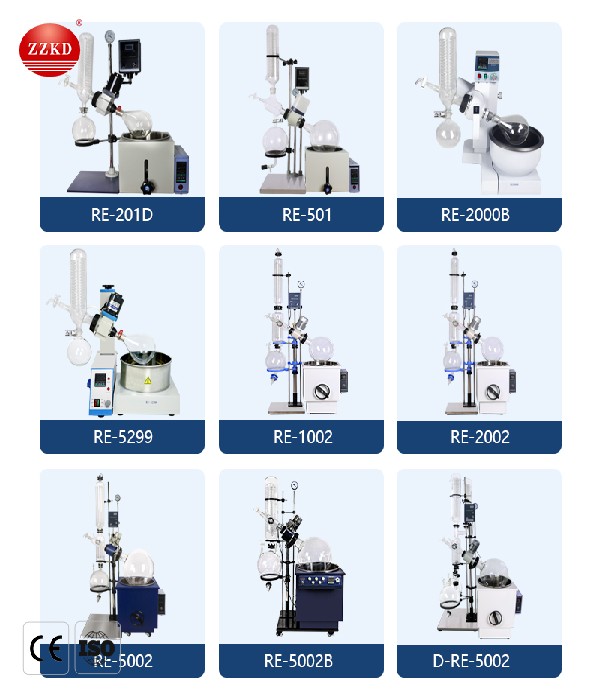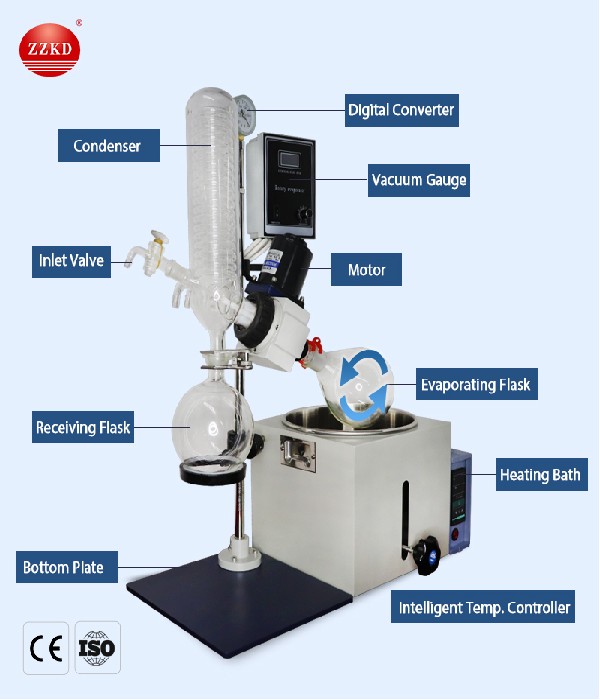How To Choose A Rotary Evaporator?
Rotary Vacuum Evaporator Description:
Rotary evaporator is one of the indispensable equipment for experiments in the laboratory, which consists of heating bath, evaporating flask, condenser tube, etc. By controlling, the evaporating flask is constantly rotated at an appropriate rotation speed, and the evaporating flask is placed in a heating bath to perform constant temperature heating while rotating, thereby uniformly heating the reaction solvent in the evaporating flask. During rotation, the reaction medium adheres to the walls of the evaporating flask, which increases the evaporation area. Use a circulating water vacuum pump to keep the evaporating flask in a negative pressure state, reduce the evaporation temperature of the solution in the evaporating flask under the negative pressure state, and speed up the evaporation rate. The coils of the high-efficiency cooler pass with the cooling medium to liquefy the distillate vapor for separation.
The rotary evaporator rotates at a constant speed under constant temperature heating and vacuum conditions, so that the reaction solvent forms a film on the wall of the rotating bottle. After effective evaporation, the solvent is cooled and recovered by a glass condenser, which can effectively improve the work efficiency. At present, the rotary evaporator is not only an instrument and equipment in most scientific research laboratories such as food, medicine, biology, etc., but is mainly used for material concentration, crystallization, drying, separation, solvent recovery and extraction (such as for the extraction of celery leaf essential oil. essential oil evaporator), meanwhile, rotary evaporator uses in industry is also worthy of attention.
The following points can be used as the basis for you to choose and buy a rotary evaporator:
1. Confined space of rotary evaporator
The closed space of the rotary evaporator is composed of glass components such as evaporating bottle, receiving bottle, sealing ring, condenser tube, vacuum buffer bottle, vacuum pump and vacuum pipeline. Among these components, the vacuum degree of the entire system is particularly critical and will be affected by the outside world. The variable factors are: vacuum pump, seals and vacuum tubes.2. Lifting method of rotary evaporator
Lifting methods are divided into manual lifting and automatic lifting, and automatic lifting is also divided into: automatic lifting of water bath and automatic lifting of evaporating bottle. Automatic lifting rotary evaporator is mainly suitable for those who use it frequently, and automatic lifting saves a little effort. In fact, the advantages of water bath lifting: it can protect the evaporating bottle, the glass shaft is not easy to be damaged, and manual lifting is more economical than automatic lifting, such as the RE-201D small-capacity rotary evaporation produced and sold by our company. The instrument is very cost-effective!
3. Sealing degree of rotary evaporator:
Look at the sealing degree of the rotary evaporator, that is, the vacuum degree. The higher the vacuum degree, the faster the evaporation rate. Generally, the vacuum degree can reach 0.095mpa. Generally, 2L and 5L can be equipped with a desktop circulating water vacuum pump, and a vertical circulating water vacuum pump should be equipped with a 10L or more. The degree of vacuum also has a lot to do with the sealing ring. Generally, the quality of the sealing ring is good. Some are more corrosion-resistant, so that any flux will not affect the vacuum pump, and the service life is relatively long. In terms of the vacuum degree in the rotary evaporator, the recommended vacuum degree in the industry is 95~98kPa; in terms of the temperature of the cooling medium of the condenser, the relationship between the material temperature and the vacuum degree is in line with the relationship between the material saturation temperature and the saturation pressure. When the temperature and vacuum degree are determined, the temperature of the cooling medium depends on the type of material.4. Specifications of Rotary Evaporator
The specifications of the rotary evaporator are usually distinguished by the volume of the evaporating flask, and its size depends on the quantity of the material to be evaporated. In general, 1L, 2L, 3L, and 5L rotary evaporators are suitable for small sample test in laboratory; 5L, 10L, and 20L are suitable for pilot test; 20L and 50L are suitable for pilot test and production.5. Distillation efficiency of rotary evaporator
The distillation efficiency of the rotary evaporator determines the output. In the case of the same solvent, the higher the distillation efficiency, the greater the number of samples to be distilled. If the sample volume is large, it is necessary to choose the best one in terms of distillation efficiency.6. Security risk assessment
If the distillation solvent is flammable and explosive, the rotary evaporator with explosion-proof glass components is mainly selected. In order to optimize the laboratory environment, a secondary condensing device can also be selected to maximize the recovery of the distillation solvent.Compare, did you choose the right one?
The description of rotary vacuum evaporator is here. The next article will introduce rotary evaporator uses in industry in detail.
In addition, if you want to buy a rotary evaporator, whether it is a large-capacity rotovap machine or a small-capacity rotary evaporator (such as re 501 rotary evaporator), be sure to contact us in time! We will give you a quote that will satisfy you!




